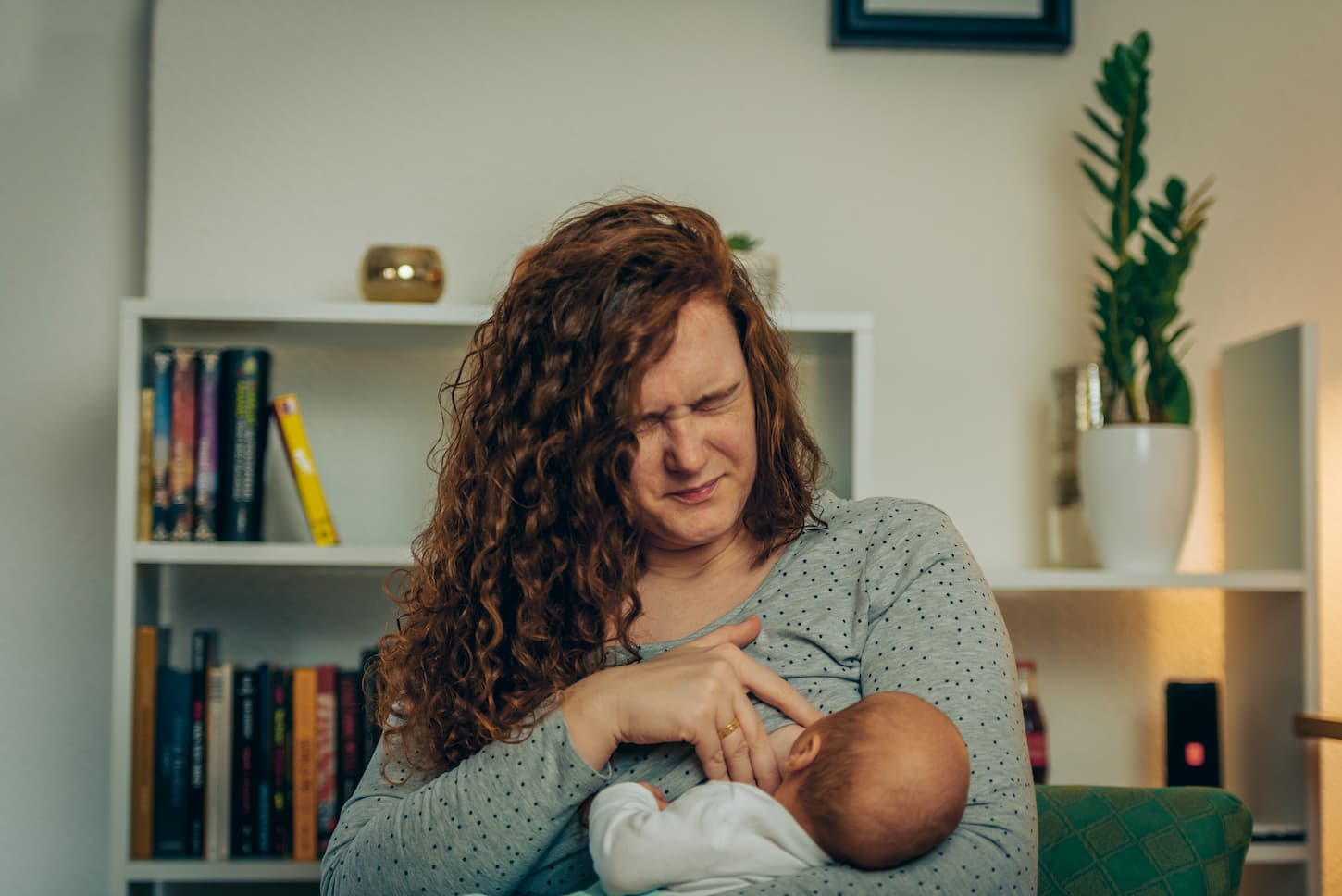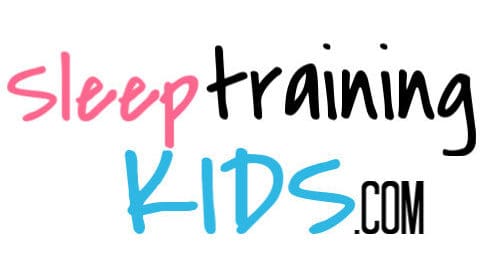Breastfeeding isn’t just about giving your baby food. It’s also a deeply bonding experience between you and your child. And if your nipples become sore then this loving act can quickly turn into a nightmare.
Feeding a baby from sore cracked or bleeding nipples can be so painful that a mother may reasonably want to stop breastfeeding. Moms should address underlying issues that cause soreness by adjusting the baby’s suck and positioning. Treat sore nipples with lanolin, pumping, and bottle-feeding baby.
The good news is that with the right care, you can quickly soothe dry and cracked nipples. Find out how in our essential guide to feeding your baby from bleeding nipples.

Are Painful, Cracked Nipples Normal?
Dried, cracked, and bleeding nipples are very common among nursing mothers. But this doesn’t mean that bleeding nipples are normal. Bleeding nipples are abnormal and usually indicate another problem, the most important one being that your baby isn’t sucking properly.
In the first week of breastfeeding your baby, it’s normal to find the sensation strange and even a bit painful. But after a few days, it should start to feel less painful and more comfortable. If you continue to feel pain after a week or your nipples become cracked, this could mean that your baby is having problems feeding.
If you’re having issues, make sure you talk to a lactation consultant. They can help you fix your baby’s latch, positioning, and how they suck. You may need to use a shield to get a proper latch. But don’t worry – we won’t leave you hanging. Next, we’ll discuss all the reasons why nipples crack. That way you’ll have answers even if you don’t talk to a lactation consultant.
What Causes Cracked Nipples?
Finding out the cause of your cracked nipples is essential when it comes to making them better. Below we’ll take a look at the main reasons why your nipples might become dry and cracked.
Cause #1: Improper latch and position
If your baby doesn’t latch on to your nipples properly during feeding this can cause your nipples to become very sore. Poor latching is the most common cause of dry, cracked, or bleeding nipples.
If your baby isn’t latching on properly then this isn’t just painful for you, it also means that your baby isn’t feeding properly. And this can lead to malnourishment, stunted growth, and other health problems. So please don’t try to just power through it. It isn’t helping you or your baby.
This is why you must take your time to get your baby latching on to your nipple right from the very first feed. If you’re concerned that your baby isn’t latching on correctly then you must get advice from your doctor or lactation consultant.
Keep in mind, too, that positioning affects a baby’s latch. So if you can’t get your baby to latch properly with one hold, try another. For example, my kids could not latch properly with the “football” hold. They would only latch properly with the traditional baby or cross-body hold.
Cause #2: Aggressive sucking
If your baby is sucking too hard then this can also make your nipples dry and sore. Your baby will suck aggressively when hungry. So one way to stop your baby sucking too hard is to feed more regularly, before the hunger sets in.
Babies will suck harder at the start of feeding to stimulate the milk flow. So to prevent aggressive sucking you can massage your breasts and nipples before feeding. This will help to get the milk flowing before your baby latches on.
You may also want to pump for a few minutes before and after nursing your baby. This can help speed up the letdown (if you pump before nursing) and increase your milk production (pumping after nursing). If you do pump before nursing, just be careful with how much you do pump out – or your baby may end up even hungrier at its next feeding session which will cause her to suck even harder.
Cause #3: Skin conditions
Cracked and dry skin on your nipples can be a symptom of skin conditions such as thrush or eczema.
Thrush will usually be accompanied by itching. Your baby may also have symptoms of thrush in their mouth.
With eczema, you’ll usually have flakey skin. If you think you have a skin complaint then talk to your doctor about specific treatments for these conditions.
Proper diet, nutrition, and moisturizing can help alleviate both of these issues. Your doctor can prescribe medicated ointments if needed.
Cause #4: Nipple Anatomy
If you have flat or inverted nipples, then your baby may struggle to latch on to them. So this can potentially make your nipples sore too. Speak to your health care professional about methods to feed your baby with flat or inverted nipples. There are nipple shields you can use while breastfeeding that will make things a lot better.
If your breasts are swollen and engorged then your baby will also struggle to latch on. In this case, you can try pumping some milk from your breasts first. This will make your breasts a bit smaller and the nipple more accessible for your baby to latch onto.
Cause #5: Baby’s Anatomy
Sometimes babies have a hard time sucking because of their mouths. They may have a shortened frenulum. This is the skin that holds your baby’s tongue to the bottom of the mouth. Babies with this condition are known as tongue-tied babies.
If your baby is tongue-tied then getting a good latch on your nipple will be a problem. Get a health professional to check your baby’s tongue and mouth if you’re having continued problems with latching.
Okay, so technically there is a second frenulum that could be another cause for a difficult suck. This second frenulum is the skin that attaches from the top gums to the upper lip. This one is far less likely to be the cause of any sucking difficulties, though.
Cause #6: Breast Pumps with improper fits
Breast pumps, when they’re not used or fitted properly can also cause cracked nipples. You should make sure that the pump fits well. Also, make sure that you’re not using too much suction.
The breast pump’s instructions will be able to walk you through making sure you’ve got a proper fit. Most pump kits should come with or offer additional-sized shields to get a better fit.

Can you Still Breastfeed if Your Nipples are Bleeding?
Although it may be painful and uncomfortable, you can still feed your baby from bleeding nipples. It’s fine for your baby to ingest small amounts of your blood. The only risk from this is that your baby may develop a mildly upset tummy.
You should breastfeed your baby for as many months as you can. So if you have bleeding nipples then try to see it as a minor setback rather than a reason to stop breastfeeding. Bleeding nipples won’t last forever and can heal quickly with the right treatment.
The only instance when you shouldn’t feed your baby from bleeding nipples is if you have toxoplasmosis or hepatitis C. These can be transmitted to your baby through your blood. If you have any transmittable diseases then speak to a healthcare professional before feeding your baby from bleeding nipples.
In my experience as a mom and as a nurse, most bleeding nipples healed within 1-2 days with proper treatment. So it really is a short-term issue. Just make sure you treat them right away. And be sure to ask your doctor (either your ob/gyn or your regular doctor) for advice if you need it.
How do You Feed a Baby With Cracked Nipples?
Feeding your baby from cracked or bleeding nipples can be painful, uncomfortable, and even unbearable sometimes. But don’t worry, here are a few things you can do to make the task more bearable.
- To relieve the pain from cracked nipples during feeding then you can take a painkiller half an hour before. Some painkillers are safe to use when you’re breastfeeding. But always make sure that you check with your doctor first before using painkillers during nursing. Most doctors will say that a small amount of Tylenol is still okay while nursing. At least mine did!
- Sometimes when you change your baby’s feeding position, this can help with the pain. You should experiment with different feeding positions until you find the most comfortable one.
- Always feed your baby from the least affected breast first. Your baby will suck more aggressively in the first minutes of feeding. Change breasts when your baby has a more relaxed sucking rhythm.
- Once your baby has finished feeding then you should remove your nipple from the mouth. You shouldn’t let your baby’s comfort suck on your nipples if they’re dry and cracked.
- When your baby has finished feeding, you should detach gently instead of pulling away. You can do this by putting your little finger into the corner of your baby’s mouth. This will make your baby’s mouth open its mouth and thus break the seal.
- Feeding your baby more frequently can help a lot when it comes to sore nipples. When you feed more frequently, your baby won’t be as hungry so technically sucking should be less aggressive. Regular feeding will also stop your breasts from becoming engorged making it easier for your baby to latch on.
- When you’ve finished feeding your baby, use a cold compress on your nipples to soothe them.
- Don’t forget to apply the lanolin to sore or cracked nipples! It’s sticky as all get-out, but it really does help sore nipples to heal faster with all that extra moisturizing going on. Be sure to clean the area thoroughly with soap and water before applying it, though, or you could trap bacteria that will raise your risk of mastitis.
All of these tips should help you breastfeed your baby just fine until you’ve healed.
Pro tip: if you’ve got sore or cracked nipples, always wash the area with soap and water. Keep an eye out for symptoms of mastitis (redness, warmth, swelling, pain). If you notice any of those symptoms, please talk to your healthcare provider immediately as mastitis may need medical treatment.
Will Bleeding Nipples Heal if you Keep Breastfeeding?
In many cases, bleeding nipples will heal just fine if you keep breastfeeding as long as you’re treating the underlying issues and taking care of yourself. However, in some more severe or painful cases, then bleeding nipples generally won’t get better alone. And, in those cases, feeding your baby from them without treatment may just make things worse. But expressing the milk is essential if you want your body to keep producing it.
A good solution to this is to use a breast pump for 24-48 hours. You can feed your baby expressed breast milk from a bottle, and this will give your nipples a break from your baby’s mouth. This should be enough time for your nipples to start healing.

How to Help Heal and Soothe Cracked Nipples?
Once you’ve identified the cause, there are lots of things you can do to give your nipples the best chances of healing. Take a look at our tips below on how to keep your nipples healthy.
Tip #1: Use good hygiene and keep clean
Good hygiene is essential when it comes to nipple care. And the last thing you want on top of sore nipples is for an infection to take hold too. When you practice good hygiene you’ll keep the risk of infection to a minimum.
To do this then make sure that you wash your hands before touching your cracked nipples. And always take the time to clean and wash your nipples before and after feeding.
Once you’ve cleaned your nipples, leave your bra off for a while. It’s better to let sore nipples air dry rather than rub them with a towel. Good airflow around your breasts will also help soothe your cracked nipples.
Applying lanolin to a clean breast can also help speed healing. But that’s the next tip.
Tip #2: Apply soothing ointments
You can use a range of natural or pharmaceutical products on your nipples for a soothing effect. Natural options include chamomile tea, coconut oil, lanolin, aloe vera, or basil leaves.
You can even use a small bit of your breast milk on your nipples, as this has lots of soothing and therapeutic properties. However, you shouldn’t use breast milk if your nipple dryness is caused by thrush. A yeast infection will be irritated by breast milk.
You can also choose from a range of antibacterial ointments made especially for breastfeeding. Always ask for advice from your pharmacist or doctor when using these products. Some of them need to be removed before you breastfeed.
Other options include using a soothing hydrogel dressing on your breast between feeds. And the most popular option amongst mothers is using a lanolin ointment. Lanolin is thought to quickly soothe cracked nipples by providing moisture.
And lastly, avoid using harsh soap or any other fragranced products on your nipples when they’re cracked. These can irritate and dry your nipples even more.
Tip #3: Be strategic in your use of bras and pads
Your bra and pads play a big role in keeping your breasts and nipples healthy. So make sure that your bra is well fitted and doesn’t cause friction around your nipples.
It’s better to wear bras made from breathable fabrics such as cotton. You should change pads regularly, and you shouldn’t wear breast pads that are lined with plastic. These aren’t breathable and can make cracked nipples worse.
For extra protection, you can invest in breast shells. These protect your nipples in between feedings. You should always consult a medical professional if you want to use a breast shell while you’re pregnant.
Some mothers will use a nipple shield to protect their cracked nipples. These are used during feeding and will protect your nipple from the baby’s mouth. But bear in mind that your baby may not feed properly from a nipple shield so they should only be used as a short-term solution.

How Long do Cracked Nipples Take to Heal When You’re Breastfeeding?
The time it takes for your nipple to heal will vary depending on how severe the soreness or cracks are. In general, though, most cases take 1-2 days to heal completely, with noticeable improvement seen within as little as 4-6 hours.
If you notice and address dryness in the early stages then your nipples can heal in hours or days. But in severe cases, it could take your nipples up to two to three weeks to heal.
When to Seek Help?
Your baby depends on your breast milk. This means that you shouldn’t be afraid to reach out to a professional about any issue that concerns feeding.
If you’ve followed standard advice and your nipples aren’t improving, then you should seek medical advice. And if you develop any of the following symptoms then you should seek advice sooner rather than later. These symptoms may indicate a more severe health problem.
- If the pain is unbearable and you can’t feed your baby
- If you have excessive pain even when you’re not feeding
- Red streaks and rashes appear on your breasts
- Any symptoms of infection such as pus, fever, or swollen lymph glands
- Any hard areas or lumps on your breasts
- If you can’t pull milk from your breasts
Seriously. If you are at all worried, please call your OB/GYN and/or your general practitioner. They can often diagnose the problem just over a phone call and get you on the right path towards healing.
Final Thoughts and Product Recommendations
Cracked and bleeding nipples are just another challenge in the rewarding experience of motherhood. But you must find out the cause and address symptoms quickly. Because if left unattended, cracked nipples can become excruciatingly painful. But with a little bit of care and attention, you can overcome nipple pain. And make breastfeeding once again a pleasant and bonding experience.
And if you need some products that will help speed that process along, here are several that have proven helpful to me and others I’ve talked to.
- The Medela hand pump I used and recommend (click to see pricing on Amazon). This thing was amazing, but you will get a really good forearm and grip workout using it.
- The Medela freestyle pump that I used with all four of my children (see the updated pump on Amazon). This is my go-to recommendation for pumps. It is expensive, though. So talk to your insurance company – they may cover some or all of the fee if you get a prescription for it.
- An affordable breast pump by Bellababy (on Amazon). This is a great option if you don’t want to spend a bundle on a pump, especially if you can’t get your insurance to cover a pump. I haven’t tried it, but I have heard great things about it.
- Breast shells to protect sore moms (on Amazon).
- Medela shields to help with difficult latches (click to see pricing).
- Lanolin cream (on Amazon) – but be sure to shop prices at your local grocery stores with a baby section.
And one final reminder before you go. Remember, you must consult a professional if you think your baby is having problems feeding or if you’re having issues healing. Because both you and your baby are worth it!
Resources
Learning about parenting or sleep training techniques is important to learn from various reputable sources. These are the sources used in this article and our research to be more informed as parents.
- “Breastfeeding with Sore Nipples.” La Leche League International, 6 Aug. 2020, www.llli.org/breastfeeding-info/breastfeeding-sore-nipples/.
